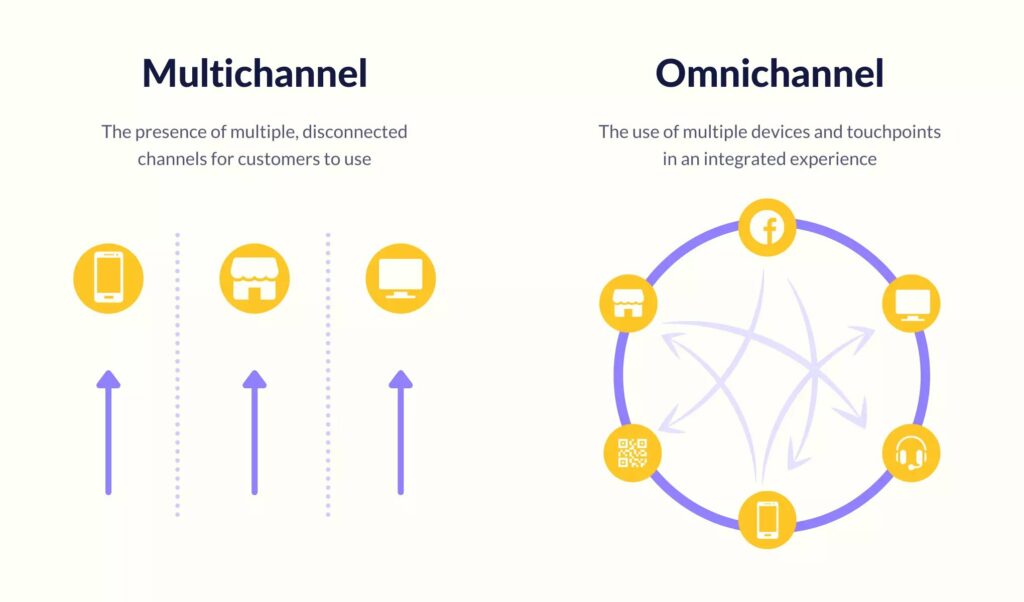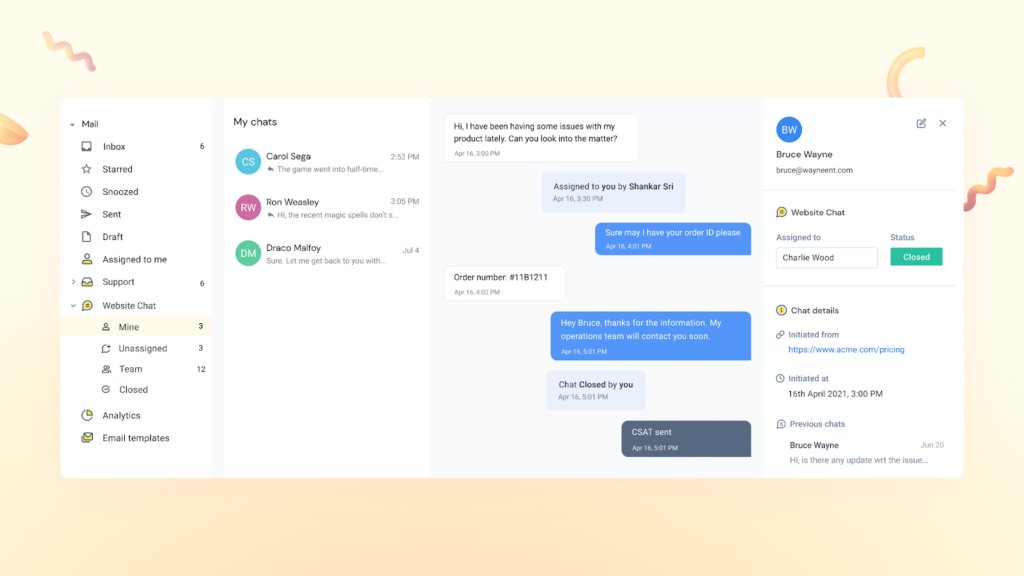
Table of contents
Turn Gmail into a collaborative hub
Omnichannel Customer Support 101: Everything You Need To Know

Table of contents
Imagine this for a second: Your customer support is a bustling city subway system. Now, each transport line represents a different communication channel — email, chat, social media, and so on.
If each of these lines operated in isolation without any interconnections, imagine the chaos!
Passengers (or customers) would be hopping off one, walking miles, and then catching another to reach their destination. Instead, a well-integrated subway system offers smooth transitions, with stations where multiple lines meet, allowing for easy switches.
That’s the beauty of omnichannel customer support. It’s the interconnected station in the vast subway of customer interactions, ensuring a smooth and consistent journey.
As for the business, omnichannel support can help them with a consolidated view of all customer interactions, helping their support team solve queries much faster.
But before we deep-dive into omnichannel support, let’s understand how it is different from multichannel support:
Omnichannel vs. Multichannel: What is The Difference?
First, it’s essential to distinguish between multichannel and omnichannel, as the terms are often used interchangeably. But they’re not quite the same:

Multichannel Support
It’s like setting up several stands to sell your products — one on the street, another at a local market, and one more online. Each stand works independently. You’re reaching people in different places, but if a customer moves from one spot to another, they start the process all over again.
In the context of customer support, this could mean using email, chat, social media, and phone, but each channel remains isolated from each other. So, if a client starts an email conversation and then switches to a chat, they would have to explain their issue from scratch.
Omnichannel Support
Here, the scenario changes. Imagine those same stands, but now, if someone checks a product online and then visits the local market, the seller already knows their preferences.
Customers can hop between email, chat, social media, and other communication modes, and the context moves with them. Tools like Hiver ensure that there’s continuity, and the customer doesn’t need to repeat themselves.
Key Components of Omnichannel Support
Omnichannel support isn’t just a buzzword; it’s a strategic approach to customer service. At its core, it’s about ensuring consistent, high-quality interactions across all channels. Let’s delve into its key components to understand its architecture better.
1. Integrated Platforms
Integration is the heartbeat of omnichannel. Whether it’s integrating chatbots with email systems or social media with CRM, these connections ensure that customer data is consistent across channels.
For instance, with tools like Hiver, agents can view all interactions, be it from chat or email, under the same roof. This prevents any potential hiccups or misinformation when serving clients.

Connecting various platforms and tools is crucial for an effective omnichannel support strategy. Here are some key integrations that can significantly enhance your customer support experience:
- CRM Software: This helps in centralizing all interactions with current and potential customers. This makes it easier for customer service reps to offer personalized service. Some top tools in this segment include Salesforce and HubSpot.
- Email SupportPlatform: For routing, collaborating, and tracking emails and also for combining email history with other customer interactions from platforms like Gmail.
- Chatbots: Chatbots can handle initial queries or FAQs. If the issue is more complicated, it can be redirected to a human agent.
- Live Chat: Essential for real-time support. The live chat transcripts can be saved and used for future reference.
- Social Media Platforms: To monitor and respond to customer queries or complaints on social media. These include platforms like Facebook and Instagram.
- Knowledge Base: This can be integrated so that both support agents and chatbots can pull up relevant articles to assist customers.
- Voice Support: Voice support can be integrated to record calls and save them for future reference, which can be valuable for training and quality purposes.
- Feedback and Survey Tools: These can be automated to send post-interaction surveys to gather feedback and improve services. Customer service tools like Hiver also offer an in-built survey feature to measure customer satisfaction.
- Payment Gateways: Sometimes, support involves billing issues. Having this integration allows for quick and easy resolution of such matters.
Hiver offers all the necessary integrations required to offer support via any channel — from email and live chat to knowledge base, WhatsApp, and voice.
2. Easy-To-Use Customer Service Tool
Your customer service platform lies at the center of your omnichannel support — to which all your channels will be connected. Implementing omnichannel strategies means ensuring your team is well-equipped to handle this new, integrated approach easily.
However, a lot of customer service tools in the market are complicated to use and require extensive training — which could be a very time-consuming process.
It’s important to choose the right platform to build and scale omnichannel support — one that is intuitive, uncluttered, and requires minimum training to get started.

One such customer service tool is Hiver. With a clean, intuitive UI that sits on top of Gmail, you can get started with all your customer support operations in an hour.
3. Centralized Data
Data drives decisions. However, scattered pieces of information can hinder its true potential. It becomes like a jigsaw puzzle with pieces missing. For omnichannel support to work, you need to bring all your puzzle pieces, that is, data from customer interactions, under one roof.
Centralized data is like having a detailed biography of each customer that any agent can access. This means quicker resolution times and more personalized service because the agent already knows the customer’s story.
Say a customer who has been purchasing from an online electronic store for years is currently facing a problem. Now, without centralized data on customer interactions, the customer will have to repeat their order ID, the product they purchased, and the issue over and over again whenever they reach out for support.
With centralized data, all the information from previous conversations is already with the agent who is interacting with the customer. By simply asking the customer for their customer or product ID, they can start resolving the issue or give updates without the customer having to repeat the details.
4. Feedback Loops
While the omnichannel approach provides an integrated customer experience, it’s not a one-size-fits-all strategy that can be left on autopilot. Customer preferences evolve, and technologies change. Therefore, it’s essential to keep the lines of communication open and actively seek feedback. Think of omnichannel support as a living, breathing entity that needs regular check-ups.
Feedback loops play a pivotal role in this continuous improvement process. By consistently gathering and analyzing customer feedback, businesses can detect potential areas of friction or dissatisfaction. It’s about being proactive rather than reactive.
Moreover, it’s essential to remember that feedback doesn’t always highlight problems. It can also shine a light on what’s working, allowing businesses to amplify these positives further. By keeping the system inherently customer-centric and making iterative refinements based on genuine feedback, companies ensure that their omnichannel strategy is always aligned with actual customer needs and preferences.
Benefits of Omnichannel Support
The adoption of omnichannel is not just about keeping up with tech trends; it’s about revolutionizing the customer experience. Here are some advantages of choosing omnichannel support:
1. Consistent Experience
Omnichannel support ensures every customer interaction is consistent, no matter which channel they choose. Consider this: a customer starts a conversation on a chatbot and then moves to email for more in-depth assistance.
With an omnichannel approach, there’s no need to repeat information; the customer’s history and context travel with them. It’s like watching a movie on your tablet during a commute and then seamlessly continuing on your TV when you get home.
2. Enhanced Customer Insights
Every touchpoint provides valuable data about customer preferences, behavior, and pain points. With an omnichannel strategy, businesses can connect these dots to create a comprehensive customer profile.
Again, think of it as a jigsaw puzzle. Each interaction is a piece. When combined, they offer a complete picture, allowing companies to tailor their service and products accordingly.
For instance, say, Carl, a frequent buyer at a home decor store, has a history of purchasing wooden articles. With this information, the business can reach out to him when a new line of wooden furniture or home decor items is launched — which he might be interested in. A win-win for both the business and the customer.
3. Increased Efficiency
For support teams, shifting between isolated channels can be cumbersome. Switching between applications drains productivity, and getting information from several different channels interrupts workflow.
But when every mode of communication is interconnected, the process becomes smoother.
In an omnichannel support system, agents can quickly access information without switching platforms, reducing response times. Plus, with tools like Hiver, this interconnectedness is enhanced, offering a unified dashboard where teams can handle queries efficiently.
Conclusion
With the rapid evolution of customer communication platforms, omnichannel support isn’t just an option; it’s a necessity.
By centralizing data and prioritizing feedback loops, businesses can not only meet but exceed customer expectations, paving the way for long-lasting relationships and brand loyalty.
Embracing it means truly understanding and valuing your customers’ time and experience. In the end, it’s about ensuring that every interaction with your brand is smooth and consistent.
If you are looking for a platform to manage all your support channels right from Gmail — try Hiver free for 7 days and take your customer experience to the next level.

































